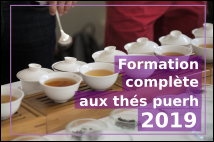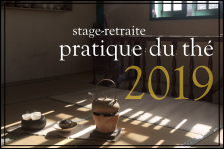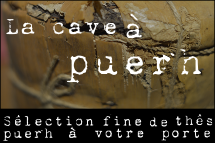







ENCOUNTERS OVER PUERH
Since its first incarnation in 2012, Rencontres autour du thé puerh (Encounters Over Puerh) has become an unrivaled, can’t miss event for tea lovers. Every two years, we offer a series of events, tastings, workshops, and trainings designed to help you discover the truly remarkable richness and breadth of puerh (Pu Er tea) tea.
Each edition of the program focuses on a specific aspect of puerh, puerh (Pu Er tea) cultivation, and puerh (Pu Er tea) culture. For this year’s 6th edition, we have chosen to focus on green puerh.
2018 SUPER GREEN
When most people think of puerh, they usually picture it in its fermented form – dark leaves, dark liquor, earthy aromas and flavors, and so forth. Indeed, puerh (Pu Er tea) is, in fact, traditionally classified as hei cha, black or dark tea (not to be confused with hong cha, or red tea, which is what we are talking about when we say “black tea” in the West).
Indeed, this dark style of puerh (Pu Er tea) is the main kind that has been consumed for over a hundred years in Hong Kong and Ghuanzhou, where the art of puerh (Pu Er tea) aging and maturation has found its most thorough and rigorous expression to date (a topic which we covered in our 2015 edition of Rencontres autour du thé puerh.)
It is also this same, dark version of puerh (Pu Er tea) that first appeared to westerners, often in the form of tuo cha specifically designed for the foreign market – the kind you might see on a shelf in a Chinese grocery.
But there is another form of puerh (Pu Er tea) that has become very popular in China in recent times and that the rest of the world is now beginning to discover as well. This young sheng puerh (Pu Er tea) (raw, unripened puerh (Pu Er tea) that has undergone little or no aging) is what we will call green puerh.
Green puerh (Pu Er tea) has been produced for centuries, not just in Yunnan but throughout the Golden Triangle. While it is among the oldest teas in the world, it has always existed on the margins of Chinese tea culture, and has never been considered central to the Chinese tea canon. Although this style of tea shares a great deal with green tea (its green leaves, yellow-orange liquor, and vegetal, floral, and fruity aromas stand in stark contrast to the deeper, more earthy flavors of dark puerh), green puerh (Pu Er tea) has ironically reentered the pantheon mainly because the popularity of darker puerhs, which have served as a kind of gateway or portal to its younger cousins, piquing the curiosity of tea fans all over the world.
This being said, green puerh (Pu Er tea) has also itself changed quite a bit in the last 20 years. Throughout its long history, puerh (Pu Er tea) has never been consumed in as “green” a form as it is today.
This 6th edition of Rencontres autour du thé puerh, “Super Green,” is geared towards discovering, exploring, and analyzing these greener shades within the world of puerh.
“Super Green”: Puerh as “super” green tea?
The goal of this edition is, first of all, to direct more attention to green puerh. Due to its particular character and the manner in which it is generally consumed today, it is useful to think of this style of tea in relation to the green tea family. Should these puerhs be considered green tea? Or, perhaps, “super” green tea?
“Super Green”: A puerh (Pu Er tea) which became “super green”?
But we must also interrogate the current trend, in which puerh (Pu Er tea) seems to be getting greener and greener with each subsequent production year, and in which puerh (Pu Er tea) processing is increasingly inspired by that of green or wulong tea. There are now some puerhs that aim for a more green, vegetal profile than even that which is permitted in green tea production in China. And there are some that, it is claimed, descend directly from the practices of the distant past, but whose very nature has changed so significantly in the last ten years that they no longer resemble what has been produced historically.
EVENTS
The 6th edition will revolve around the following axes:

Discovering
In order to help make the universe of green puerh (Pu Er tea) accessible and available to as many people as possible, this year we will be partnering with a group of renowned tea houses to offer a series of friendly and free guided tastings. These tastings, introduced and led by Olivier Schneider, will offer the opportunity to discover green puerhs of varying styles, ages, terroirs, and origins in a relaxed and informal atmosphere.
Learning
For those who would like to go further in their understanding of puerh, we will offer several learning opportunities, workshops and trainings that will focus on differing aspects of this tea family. Depending on your current level of understanding, your means and your motivation, you will be able to opt for “basic” trainings, which will provide you with a strong foundation for understanding and appreciating puerh, or “in-depth” trainings, which will help you develop a true mastery of these teas.
Experiencing
Finally, we will also offer special times where the focus will be just on experiencing these teas, truly and fully, and with all the senses. During these sessions, it will not be a matter of discovering or learning per se, but rather of engaging in our own experience of these teas with the full presence of our minds and bodies. These experimental, multisensory events will extend beyond the strict sphere of tea itself, opening onto other gustatory experiences and aesthetic realms (such as music, for example) and enhancing the overall sensitivity, creativity, and joy of the taste experiences.
Next events:
The next events will be progressively announced here, subscribe to our newsletter to be updated!





